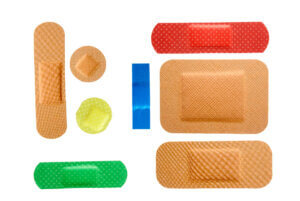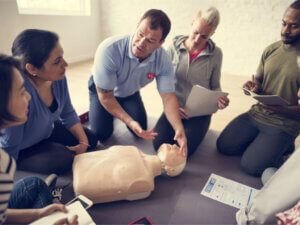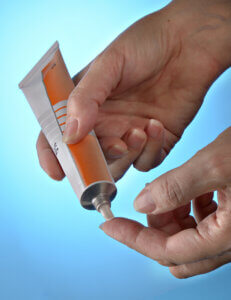First Aid Kit
Deciding on the type of First Aid Kit required

https://www.dreamstime.com/picsfive_info
Selecting the contents for a FIRST AID KIT is always a bit tricky. Every home should have one, but is your First Aid Kit fit for purpose? In an ideal world everyone should go on a St John’s Ambulance or The Red Cross course to learn about First Aid. First aid is the process of providing stabilising treatment before medical intervention is formally required. This forms life saving methods, such as cardio-pulmonary resuscitation (CPR) and safeguarding an injury from deteriorating.
A small cut may only need localised care with a sticky plaster. So the question arises, what do we need in a regular home that is reasonable? Probably the best advice is go to a pharmacy and buy the best first aid kit on offer. The click link in blue to take you to the British Standard or BS-8599-1-2019 first aid kit. I have used this link to illustrate the variety of kits available. Keep your First Aid Kit in an easily accessible location
Prices will vary enormously and many come with a plastic carrying case for easy access. Having an easy at hand kit is as important as having a fire extinguisher or flame mat. We keep ours in the kitchen. The household kit may not require all of the components of a professional or commercial kit but the trauma dressing does provide peace of mind if there is a sudden gush of blood. If you make up your own kit it should have ideally the following.
An ideal list of contents
Scissors
Sterile gloves x2 pairs
Face mask
A standard wrap bandage
A triangular splint bandage for arms
A thick (trauma) pad like gauze for serious blood loss
Small and larger gauze for wounds
A roll of tape (2.5cm wide)
Various hypoallergenic plasters
(fingers and toes often have shaped plasters)
Finger bandages, bandages for the eye
Ring pad to protect a protruding foreign body like a nail
Sterile alcohol swabs
Elasticated bandage

first aid training. Shutterstock/Rawpixel.com
Money spent on attending a first aid course with St Johns Ambulance (www.sja.org.uk) or The Red Cross (www.redcross.org.uk) will give you and your family peace of mind.
First aid courses are for everyone, not just professional people. You will also be provided with a book on first aid. Add basic life saving skills to your knowledge.
Going for medication?

https://www.dreamstime.com/stock-image-tube-cream-image21189141
Almost all ointments and creams go out of date so you do need to keep an eye on the expiry date. Antiseptic creams, sprays, flushing sachets are well worth having in your First Aid Kit
Flushing for wounds: A couple of plastic sterile syringes (5ml or 2.5ml) are useful and can be purchased from a pharmacy / chemists. Keep a few with the First Aid Kit, but throw them away after use. Saline made of ordinary cooking salt works well on wounds. My self-help article will assist here. I suggest using a 25 ml sachet of chlorhexidine or saline repacked for that emergency. You will need at least 8 sachets (200 mls) for a good flush and cleaning dirt around wounds.
Tablets: A box of 200mg ibuprofen tablets or capsules (unbranded is cheaper), 500mg paracetamol or 300mg aspirin are basic pain relief medicines. However, aspirin should not be mixed with ibuprofen or any medicine that causes the blood to thin or a clot to delay. Aspirin also as well as full strength medicines should not be given to children under a certain age.
Always keep and read the instructions before use, especially any contra-indications if you are using other medication.The most frustrating aspect of first aid kits is that medicines go out of date. Someone in the family could be allocated to take responsibility. Guess who did this in our family when I was a teenager?
First aid is a great skill even if you are not into biology. Knowing what to do can not only save lives but it prevents any injury and deterioration adding to the distress of any accident.
Please see other related safety articles
Foot injury & self-help
Feet and Safety at home
Thanks for reading ‘First Aid Kit’ written by David Tollafield
Sign-up for here my regular FREE newsfeed
Why not read – Podiatry as a career choice?
Published by Busypencilcase Communications Est. 2015 for ConsultingFootPain




Trackbacks/Pingbacks